글쓴이 보관물: nlmkhanh
How Korean retailers leverage the rising popularity of Sanrio characters to boost sales
Many domestic retailers are collaborating with Sanrio to launch products featuring Sanrio characters as consumer interest in Sanrio has considerably increased, surpassing others characters. The characters from Japanese company Sanrio are making their way into the goods market in South Korea, from coffeehouse chain’s beverages to desserts in luxury hotels.

Although the Japanese characters were first introduced to Korea in 1998, Sanrio Korea failed to gain public recognition with Hello Kitty. Sanrio Korea subsequently launched other characters such as My Melody in 1975, Cinnamoroll in 2001 and Kuromi in 2005. Those animal-shaped characters captured young adult customers’ attention, however they were limited to the local stationary market. In 2021, short-form video platforms such as TikTok and Instagram Reels have become a powerful marketing tool which expands the market reach for the character industry. Adult consumers are reported to actively engage in character consumption as the domestic character industry in Korea grows.

From April, Baskin-Robbins Korea has been engaging in partnership marketing with Sanrio. Sanrio characters such as My Melody, Hello Kitty, Cinnamoroll and Kuromi are not only featured on the Baskin-Robbins cups but the affiliate of SPC Group also introduced a variety of new desserts and. Baskin-Robbins Korea presented their official merchandise with Sanrio, including AR photocard, photocard holder, bag, mini carry bag and smart tok.
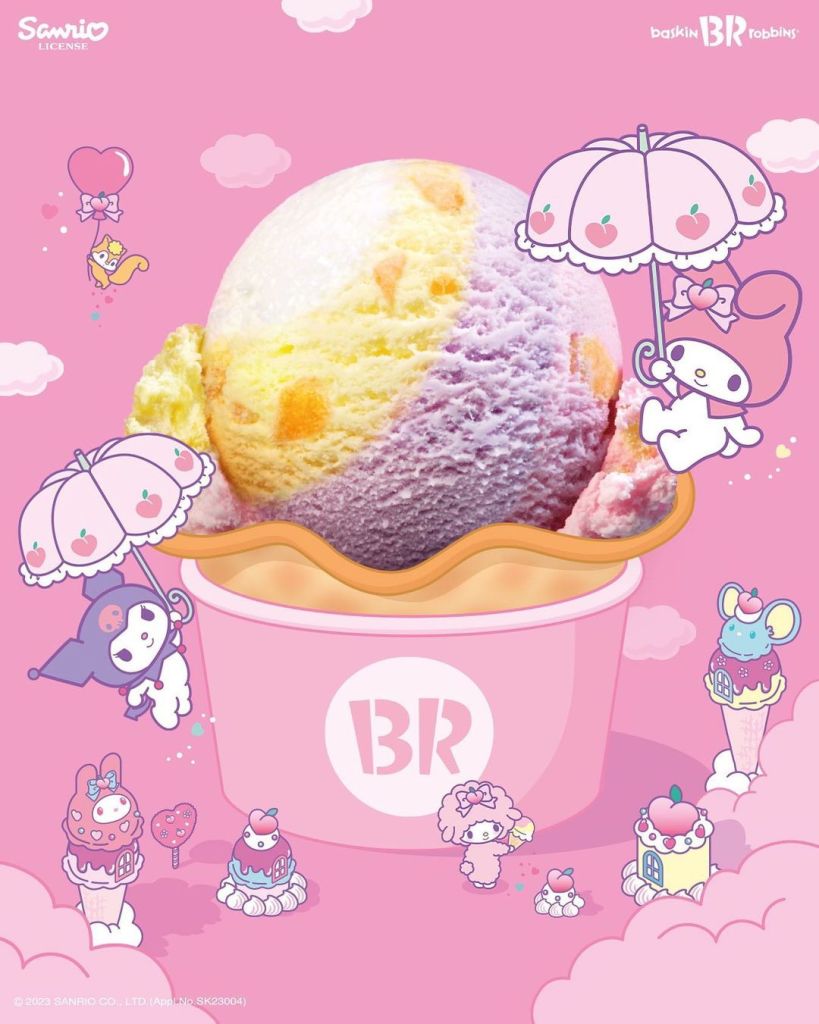

In order to promote their new flavor with Sanrio in April, they also leveraged ChatGPT to create an advertising video, featuring My Melody and Kuromi. As a part of the taste-of-the-month events, the two Sanrio characters visit Baskin Robbins castle to discover the taste of April. “Once Spoon a Time” marks the first time that a Korean firm utilized a new-concept marketing based on an AI chatbot.
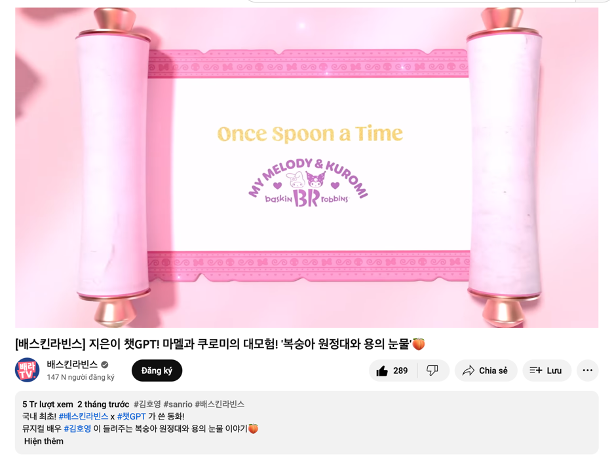
Paradise City, a hotel and resort complex located in Incheon, introduced their package deal with Sanrio characters in April, particularly My Melody and Kuromi. The 5-star complex offers exclusive Sanrio goods along with extra package benefits such as free pass to theme park Wonder Box, swimming pool, Kids Zone, fitness and Paradise Art Space. The package titled “Saranghae Paradise” will be available from mid-April to the end of August.


According to Ediya Coffee officials, they have found that interest in Sanrio Korean coffee franchise Ediya Coffee consistently remained high after analyzing search trends over the past years. The Korean coffee franchise announced their recent collaboration with Sanrio Korea to launch beverages, snacks, gift cards and merchandise featuring Sanrio characters from June 20. Ediya’s new summer beverage will be represented by a character such as My Melody for Strawberry Flatccino, Kuromi for Mango Peach Ade and Pompompurin for Choux Cream Flatccino.
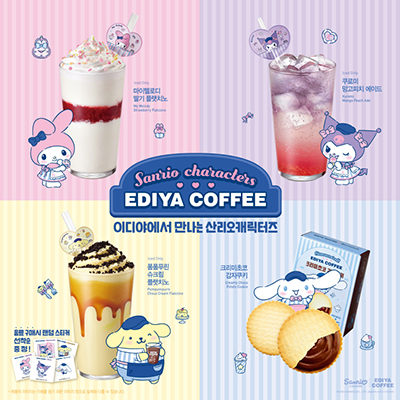
While product sales at offline stores and online malls account for 61 percent, Sanrio generates 39 percent of its revenue from licensing agreements and royalties. Domestic retailers are rushing to hop in the trend with Sanrio characters to enhance brand awareness that directly increases sales.
REFERENCE
- Hwa, J. Sanrio characters gaining popularity in Korea amid diplomatic thaw. Pulse by Maeil Business News Korea. (n.d.). https://pulsenews.co.kr/view.php?year=2023&no=446209
- Kim, H. (2023, April 30). Retailers ride on Japan marketing to boost sales. Koreatimes. https://www.koreatimes.co.kr/www/tech/2023/04/419_350005.html
- Lee, H. (2023). Baskin-Robbins Korea creates advertising video using ChatGPT. Korea News Plus. https://newsarticleinsiders.com/baskin-robbins-korea-creates-advertising-video-using-chatgpt
- Herald, K. (2017, January 31). Korean character industry grows fivefold in 10 yrs. The Korea Herald. https://m.koreaherald.com/amp/view.php?ud=20170131000690
Is Pinterest Advertising Still Worth It in 2023?
While many businesses are attempting to leverage social media marketing and adapt the evolution of AI technology, Pinterest is often under prioritized as a digital marketing tool and left behind in social media marketing strategy. Pinterest is a social media platform that allows users to discover and save ideas for various topics such as fashion, food, travel and more in the form of pinboards. Pinterest is mostly utilized to inspire and gain inspiration from contents that match their preferences for interests and hobbies. Users can save an image with a pin and organize them into a folder known as board. What makes Pinterest versatile is that each pin links with a website or post that a brand wants to increase organic traffic or sales.
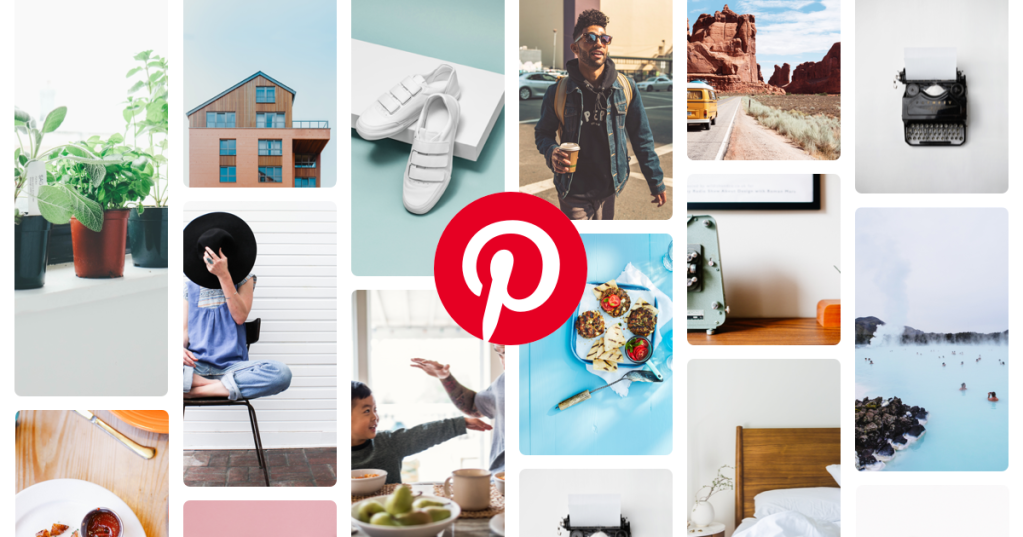
Although many businesses boost their brand awareness by focusing on social media platforms such as Facebook, Instagram and TikTok, there is a huge market for business on Pinterest. Ranking as the 14th largest social network on the internet, Pinterest is a great search engine with 445 million monthly active users. The application has seen global users growth rise at an 11 percent compound annual growth rate. It is also reported that Pinterest drives 3.8 times more than other platforms and 87 percent of its users have come to purchase decisions because of Pinterest. Many users are willing to spend on what they discover on Pinterest, indicating that businesses can use Pinterest to not only build their online presence but also to increase more traffic to websites and online stores.
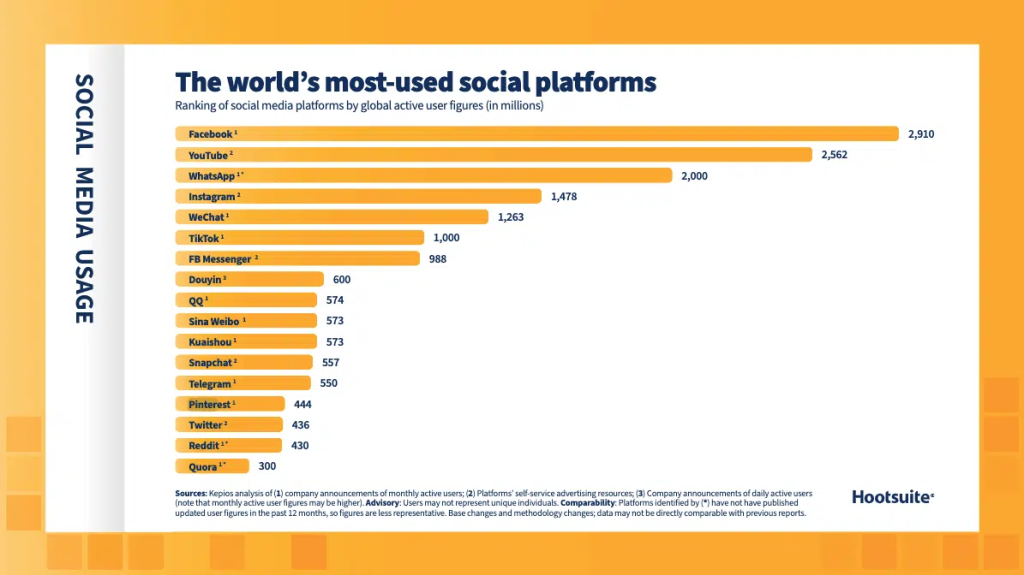
Unlike other social media platforms, Pinterest users find advertising useful as 61 percent of them make purchase decisions from promoted pins. Pinterest ads are highly effective thanks to the way its content is displayed, which makes the application different from other social networks. Pinterest users are able to view pins by a variety of ways including visiting businesses’ profiles, searching for relevant keywords, and seeing content appearing on their feed if the pins are in common with their interests.
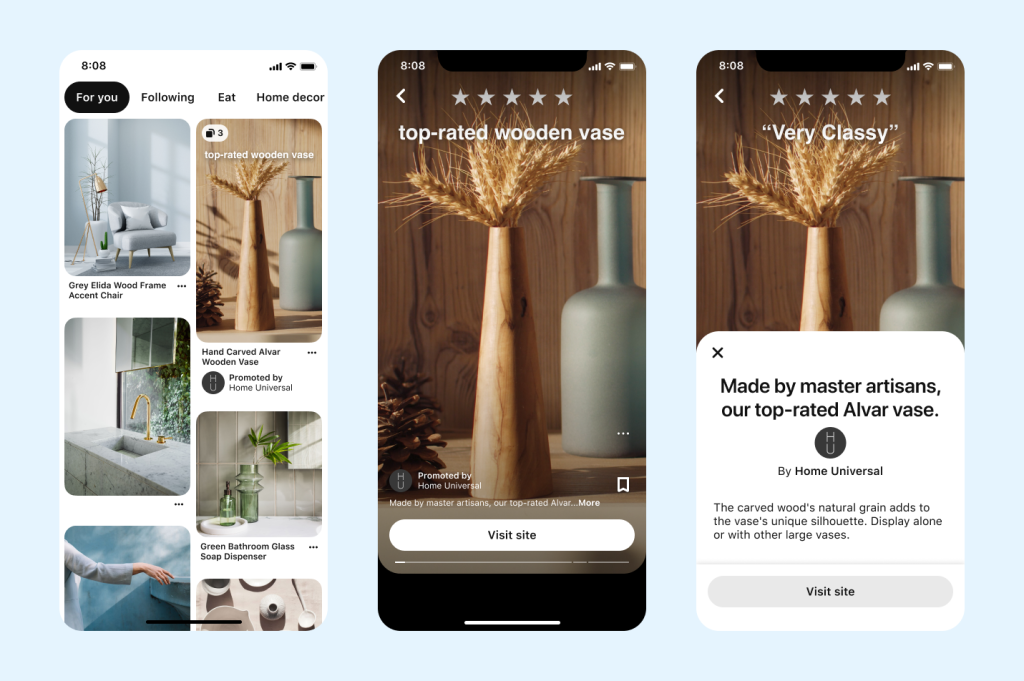

Furthermore, when a user saves a Promoted Pin, other users would see it on their feed as well, generating organic engagement and increasing additional sales. Even though the paid advertising campaigns end, the Pins themselves also last forever and your ads will always appear on users’ feed. Pinterest’s unique algorithm will circulate all of your Pins no matter when they are posted as long as they’re still available on the platform, which allow businesses to draw engagement from new audiences from a content they might have pinned years ago. Considering that many customers save products to consider and purchase them later rather than immediate purchase, Pinterest is an effective tool for businesses to sell their products or create content to reach their target audience.
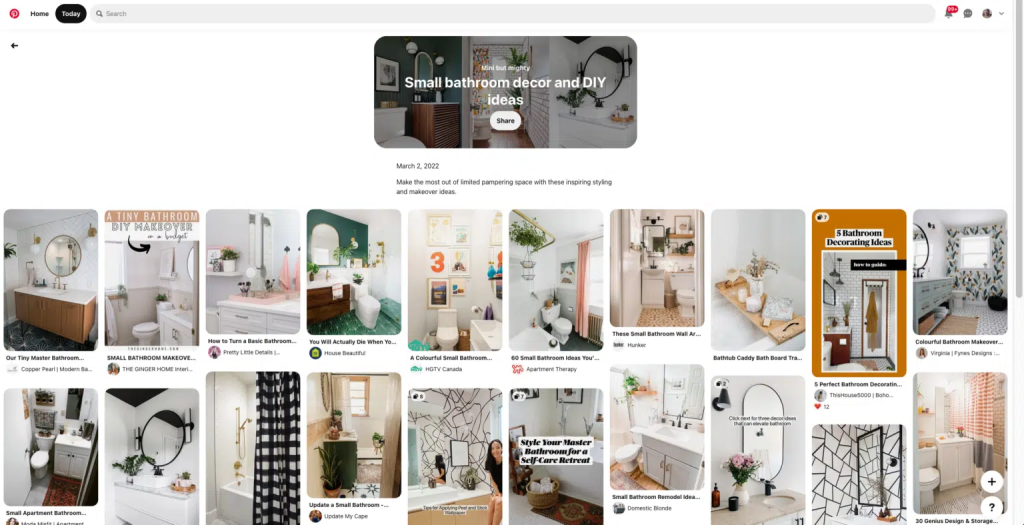
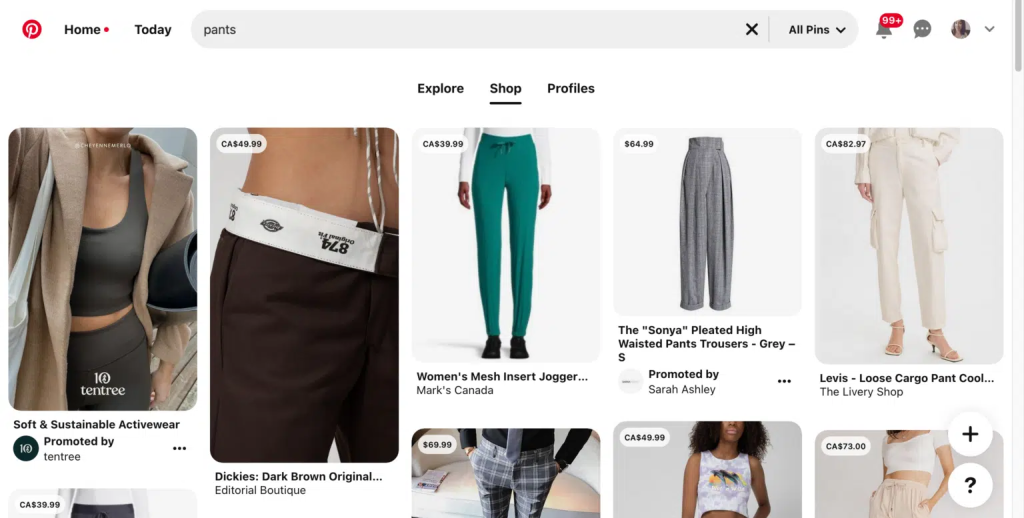
It has never been easier for small businesses to showcase their product or service to the right audience on Pinterest with a budget. Unlike many paid business growth platforms, small businesses do not have to make a cash investment for digital advertisement to grow their brand on Pinterest. The only investment small owners need to start on Pinterest advertising are effort and time as the social media platform always needs new and unique content. Pinterest is an image-based search engine, therefore businesses must keep promoting their brand with a variety of high-quality content to create online presence.
Overall, Pinterest is an underestimated platform for businesses and their social marketing strategy, yet it is a perfect tool to drive traffic and increase sales, particularly for small owners. Pinterest is definitely a great advertising powerhouse that all brands should utilize no matter what type of products they sell or service they provide.
References
- Macready, H. (2023). 38 Pinterest Stats That Matter to Marketers in 2023. Social Media Marketing & Management Dashboard. https://blog.hootsuite.com/pinterest-statistics-for-business/
- Benwait, R. (2022). Why Pinterest Is a Social Platform Worth Using for Your Business. Digital Agency Network. https://digitalagencynetwork.com/why-pinterest-is-a-social-platform-worth-using-for-your-business/
- Waldrop, M. (2023, April 20). Is Pinterest worthy of your brand’s time? Yes, here’s why. The Drum. https://www.thedrum.com/insight/2023/04/20/pinterest-worthy-your-brand-s-time-yes-here-s-why
- Martin, M. (2022). The Pinterest Shopping Features You Should Know in 2023. Social Media Marketing & Management Dashboard. https://blog.hootsuite.com/pinterest-shopping/
- Mialki, S. (2022, September 22). Pinterest Ads: Why You Should Use Them, Best Practices & More. Instapage. https://instapage.com/blog/pinterest-ads/#:~:text=Pinterest%20advertising%20can%20be%20a,before%20%E2%80%94%20especially%20from%20new%20customers.
How Will ChatGPT Influence The World of Marketing?
Artificial intelligence has been growing rapidly and language models, particularly chatbots, have generated considerable public interest as businesses seek for ways to enhance their customer service and boost audience engagement. The release of ChatGPT chatbot in November 2022 has drawn great attention as the language model is expected to revolutionize the digital marketing world.
ChatGPT is a chatbot that uses deep learning techniques to create human-like text and provide accurate responses to customer queries by its large data set. Using natural language processing and great understanding of context, ChatGPT allows businesses to enhance marketing strategies and meet customer needs when it comes to inquiries, leading to better customer satisfaction. ChatGPT cannot replace humans in marketing but it can be used to assist marketers in many areas of digital marketing including search engine optimization (SEO) and content marketing.

- SEO
ChatGPT can be leveraged to optimize websites as this language model can improve site navigation and organize websites according to the hierarchy preferred by users. The SEO strategists no longer have to spend hours manually checking the website and boosting their search ranking on Google. Instead, ChatGPT allows them to identify relevant keywords and include them in the content in order to improve their search engine ranking. Furthermore, ChatGPT can assist marketers with SEO blog posts as the site can optimize content based on the keywords that users want their blog to be ranked for. Marketers spend a significant amount of time researching keywords and this chatbot would help them leverage more powerful keywords thanks to its wealth of data, allowing them to focus on other important tasks.
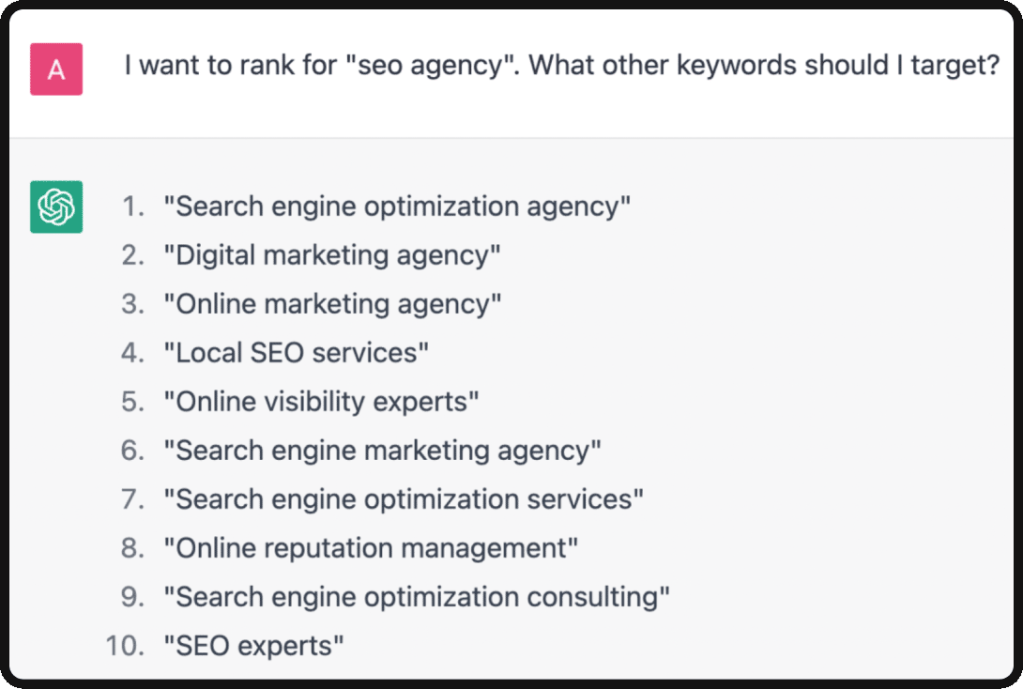
2. Content marketing
In terms of content marketing, ChatGPT allows businesses to create content that meets the specific interests and needs of their target audience yet content writers and strategists still need to further develop. The extent to which the chat bot could assist in drawing the audience’s attention, increasing engagement and driving organic traffic to the business’s social media channels or websites. The site can generate a lot of written content that sounds just like human-written, including blog post titles, product descriptions, headlines and call-to-actions. ChatGPT can also write video scripts for marketing and promotional video no matter if it is a commercial or full-length feature. When it comes to social media posts, ChatGPT can be used for various platforms such as Facebook, Twitter and Linkedin. The AI tool will find trending words in its database in order to optimize the captions for the users. In addition, the recent release of ChatGPT-4 in March 2023 is expected to have greater impact than its predecessor GPT-3. With its ability to provide high-quality text and understand the customers intent, ChatGPT-4 allows content writers to generate more personalized content and improve the effectiveness of marketing campaigns.


Overall, AI-assisted digital marketing is a powerful tool that assists businesses in quickly and accurately providing relevant and engaging content according to audiences’ personalized interests. Although ChatGPT has the potential to boost marketing efficiency, businesses should only use this AI technology to assist humans rather than replace. This language model might not be able to deal with complex and high-quality content requests which requires creativity and emotional intelligence of human marketers. As the pace of technological change is getting faster and faster, the role of digital marketers are likely to concentrate on leveraging these AI tools and natural language processing technology in order to create content that meets the needs of audiences.
References
- Fares, O. H. (n.d.). ChatGPT could be a game-changer for marketers, but it won’t replace humans any time soon. The Conversation. https://theconversation.com/chatgpt-could-be-a-game-changer-for-marketers-but-it-wont-replace-humans-any-time-soon-198053
- Frederick, B. (2023, February 7). 6 Ways SEO Pros Are Using ChatGPT Right Now. Search Engine Journal. https://www.searchenginejournal.com/ways-seos-are-using-chatgpt-right-now/475896/#close
- Raitaluoto, T. (2023, January 21). How businesses can use ChatGPT for content marketing. (n.d.). https://www.markettailor.io/blog/how-businesses-can-use-chatgpt-for-content-marketing
- Anis, A. (n.d.). The importance of chat gpt in digital marketing. https://www.linkedin.com/pulse/importance-chat-gpt-digital-marketing-amna-anis
Spotify Wrapped: The viral marketing campaign that turned December into Spotify season
Every December, Spotify provides its user what they have listened over the past 12 months including their artist preference, music taste, time spent in the app and more. The campaign was first launched in 2015 with the name “Your Year in Music” and officially renamed to “Wrapped” in 2013. The music streaming platform tracked user’s listening habits from January 1 to October 31 and visualized these data in a highly shareable and attractive format. As a result, Spotify Wrapped 2019 gained nearly 3 billion streams from Wrapped playlists. In 2020, Spotify’s mobile application downloads was increased by 21 percent in the first week of December and engaged more than 120 million users last year. Without a doube, December is the most wonderful time of the year for Spotify’s marketing team.

Spotify Wrapped 2022
- More than just music
The secret to its growing popularity is how the music service goes beyond simply analyzing a list of top favorite songs or artists. Rather, Spotify personalized the data in a clever way that communicates its users’ personality. The way we listen to music does say a lot about us and sharing our listening habits on social media has a great influence on how our online presence forms are perceived. For this reason, Spotify launched an updated version of its annual Wrapped with the “Listening Personality” feature. Inspiring from the Myers-Brigg personality test, the new “Listening Personality” feature also introduces a four-letter code for the user, which is interpreted into one of the 16 Spotify personality type. Different types of personality are created based on a combination of the music Spotify users stream and their listening traits such as their tendency to discover new song, the popularity of the artists they listen to or the average amount of time they play a song on repeat.
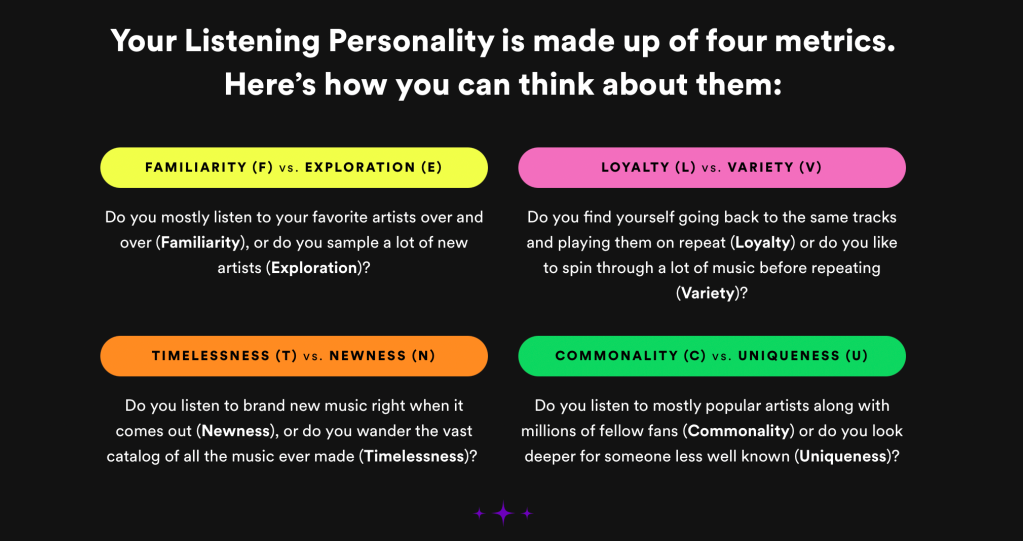
Spotify ‘Listening Personality’ feature
For example, people who are likely to search for less well-known artist and newest tracks are labeled as The Adventurer and ENVU, the abbreviation of Exploration, Newness, Variety and Uniqueness.
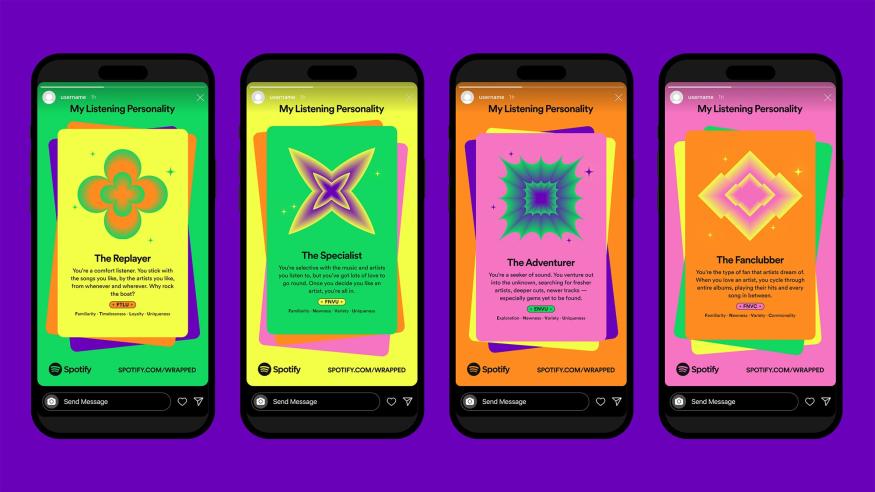
In addition, Spotify also send an email or notification if the users are in the top 1% listener of a certain artist, which allow people to show off that they’re a superfan of that artist and socially engage with others user sharing similar music taste.

2. Word-of-mouth marketing
The personalized data motivates not only users to share their Spotify Wrapped on social media but artists can also generate their own recap on the year, which are provided with their number of streams, fans, hours of listening and countries in which their music was played. Artists on the platform sharing the recap to express gratitude for their fans support has drawn more public attention to Wrapped and increase the campaign awareness.

Official Twitter account of Winner shared their Spotify Wrapped
Thanks to the colorful and creative card designed for re-sharing across all social media, Spotify succeeded in creating content that people actively want to share. This cultural phenomenon targets on customers who are left behind with the trend and leverages their fear of missing out (FOMO), enticing them to consider Spotify rather than others music streaming service. Furthermore, Wrapped can be the subject of many conversation circle as people are always curious about others’ listen personality and their top artists.
Spotify Wrapped has proven to be a great way of personalizing data to acquire new users and make them use the app long enough to become a loyal customer. Spotify users acknowledge that their datas are inevitably collected, yet the music streaming platform thrives on creating value for customers in exchange for these datas.
Reference
- Morgan. P (2020, Dec 22). Spotify Wrapped: A best in class marketing campaign. (n.d.). Metia. Retrieved December 2, 2022 from https://metia.com/blog/spotify-wrapped-a-best-in-class-marketing-campaign/?fbclid=IwAR0en97-xlIQTh_P8louWI1iem-3GjlwMJJqk2cFYnM2LrMJlH4aZBuHVmU
- Perez. S (2022, Nov 30). Spotify Wrapped 2022 arrives with new features like ‘Your Listening Personality’, 40+ Artist Messages. Retrieved December 2, 2022 from https://techcrunch.com/2022/11/30/spotify-wrapped-2022-arrives-with-new-features-like-your-listening-personality-plus-40k-artist-messages/
- Ogle. T (2022, Dec 01). Why People Share Their Spotify Wrapped to Social Media. Retrieved December 2, 2022 from https://harpersbazaar.com.au/spotify-wrapped-social-media/
- Jurberg. A (2021, Dec 07). Spotify Dominates Social Media in December Thanks To A Brilliant Annual Campaign. Retrieved December 2, 2022 from https://bettermarketing.pub/spotify-dominates-social-media-in-december-thanks-to-a-brilliant-annual-campaign-e94cb6dd4871
Offline spaces: New branding strategy for brands in Korea
To grow and thrive in the post COVID-19 “new normal”, many brands are now shifting to offline spaces, establishing a more engaging relationship with their customers and generating brand recognition. Brands are emphasizing on creating a space where millennials and Generation Z (Generation MZ) customers can experience, then give immediate feedback about their products and services. The Generation MZ grew up in the digital age and digital isn’t always better when compared to such novel analog experiences.
Offline spaces differ from traditional stores as their main purpose is not solely about selling the products. Instead, they present the core identity of the brands and grow a stronger bond with their target customers by allowing them to empathize with the brands’ aesthetics, vibe and values. Brands appeal to consumers’ emotions and speak to their hearts through experiences. Customers would visit these “Instagrammable” spaces and share their experience on social media platforms, establishing a strong two-way communication between brands and audiences.
For instance, Gucci opened its contemporary Osteria da Massimo Bottura restaurant in March, offering a dining experience that aims to bring both Italian and Korean culture together. The interior design embodies a similar aesthetic to Gucci Osteria Tokyo, including the ceiling lights, parquet flooring, colorful marble mosaic of the terrace as well as utensils from the brand. The prices of the dishes are not that affordable, varying from 28,000 won to 170,000 won, but after its opening, the reservation was full till May. The reason for the hype was not necessarily its well-known food but the opportunity to experience dining in a space filled with the designer brand’s aesthetics and employers’ attitude. Visiting a restaurant is a great approach to the high-end brands as it’s less expensive than buying their products. As people visit restaurants and cafes more often than luxury brands stores, those spaces could attract customers and make them become potential loyal customers since it’s an opportunity to get used to the brands in daily life.


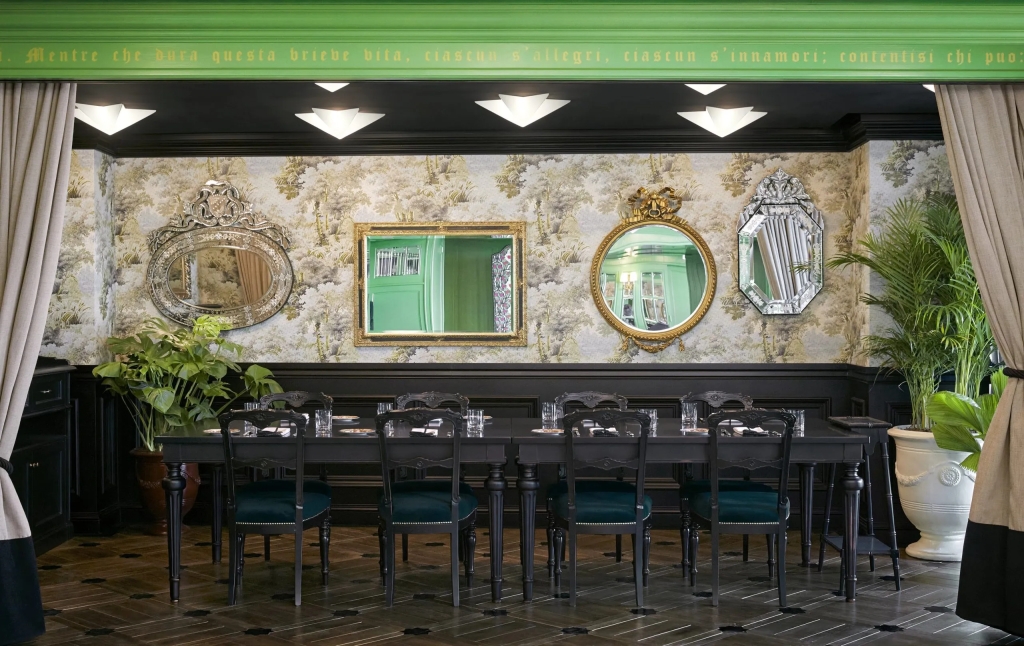
Combining online and offline spheres to create a new experience is a priority task for many online retailers today as existing in one sphere is not enough for survival. Domestic online shopping commerce Musinsa launched its flagship store in AK Hongdae last May as the need for offline shopping is recently increasing. Musinsa provided try-on services and pick up services from its online stores. It attracted 240,000 people in total from January to March this year and approximately 23,000 pick-ups for a month, accounting for 17.9 percent of the entire sales. Brands available on Musinsa application can sell exclusive products as well as offer their own content through performances, exhibitions, presentations and showcases in the area. Musinsa also launched its second offline store in Gangnam, which quickly became a new popular spot for generation MZ. After its first grand opening, 8000 people visited the store and earned a revenue of 190 million in the first three days. Musinsa Standard Gangnam is a shopping space where people can experience the fashion company’s identity ― not just try on its apparel, but also check out an art exhibition and listen to music.


References
- Seo. J (2022, May 03). Brands in Korea cater to customers by offering a full experience offline. Retrieved October 21, 2022 from https://koreajoongangdaily.joins.com/2022/05/03/culture/features/gen-z-mz-generation-jinro-soju/20220503125458474.html?fbclid=IwAR2jHDbKBHiQgRhlacz8bQ_iV2036Ym2knCENuu9hagJkfm1Z2DTdyE245A
- Byun. H (2022, Oct 04). Retail industry looks offline to drive customer experience: report. Retrieved October 21, 2022 from https://www.koreaherald.com/view.php?ud=20221004000678&fbclid=IwAR0nOsrccsM96kizag_uAp5Z-BT5mNXHqcCtqJlr-BdrjoufRdXDL_xCuQ4
- Kim. J (2022, Oct 08). Musinsa’s new store becomes hot spot in southern Seoul. Retrieved October 21, 2022 from https://www.koreatimes.co.kr/www/tech/2022/08/419_334135.html
How luxury fashion brands use TikTok as a cost-effective marketing tool
During the past two years, TikTok has afforded many valuable opportunity for luxury brands to connect with younger generations of consumers. Compared to the others app, the video-sharing social network has the highest reach for Millennial and Generation Z, making it a potential sales channel for luxury brands as these two generations will account for 180 percent of luxury markets growth from 2019 to 2025.
1. Virtual events
Luxury designers are now partnering with TikTok to livestream virtual fashion runway, which allows users to be have a part of TikTok fashion front row. Dior, one of the first luxury fashion brands to embrace TikTok, launched its Ready-to-Wear collection by Maria Grazia to TikTok. Dior Spring-Summer 2021 Collection virtual catwalk used the platform to communicate with the young audiences in a real time. Louis Vuitton, JW Anderson and Saint Laurent also joined The TikTok Fashion Month with Dior. Digital fashion shows have become essential to brand survival during the pandemic. Luxury brands are now able to reach new demographics and increase awareness of their new collection in an authentic and community-driven approach. TikTok’s social commerce potential also indicates that luxury brands could gain actual sales from digital show.

2. Unboxing
Unboxing is a concept that began in the 2000s on YouTube, where creators would show off their newly purchased products to their online audience. It quickly became a popular trend among TikTok creators. Since its launch in 2018, the concept has gained over 40 billion views on TikTok. Unboxing allows social media users to get vicarious pleasure through creators. Unlike thrift clothing and fast fashion being focused in hauls video, luxury fashion and products dominate many popular unboxing videos.
Luxury unboxing videos tend to be brands gifting the product rather than paid partnerships with influencers. Unboxing is a low-cost way to gain endorsement from leading social media creators. It creates rich marketing opportunities for luxury brands, particularly in increasing engagement with young consumers on TikTok. High-end luxury unboxing is more appealing to these customers compared to mainstream fashion. They want to learn how a specific product could fit into their life before they buy it. Unboxing helps the brands tell their story in an authentic way that resonates with the audience. Product placement with these stories could increase brand awareness.
A prominent example of the influence of TikTok unboxing is the trend of buying the cheapest thing from designers. It’s about creating a sense of luxury on a budget. The joy of the trend is the luxury packaging and unboxing experience whether it costs $8 or $8000. The #cheapestthing unboxing trend makes luxury brands become more mainstream and compelling to mass-market consumers. Overall, TikTok unboxing is a low-budget, high-returns marketing strategy for luxury brands.
3. Organic marketing
Luxury brands could benefit from TikTok trends and leverage viral engagement if they hop on a trend at the right time. Brands must pay attention to TikTok trends as most of the times these trends blow up organically at first and can boost brand sentiment if the brand itself simply encourages them rather than being heavy-handed.
For example, the infamous Harry Styles’s cardigan had inspired a knitting TikTok trend when Styles wore a JW Anderson rainbow cardigan at a rehearsal for the Today show.
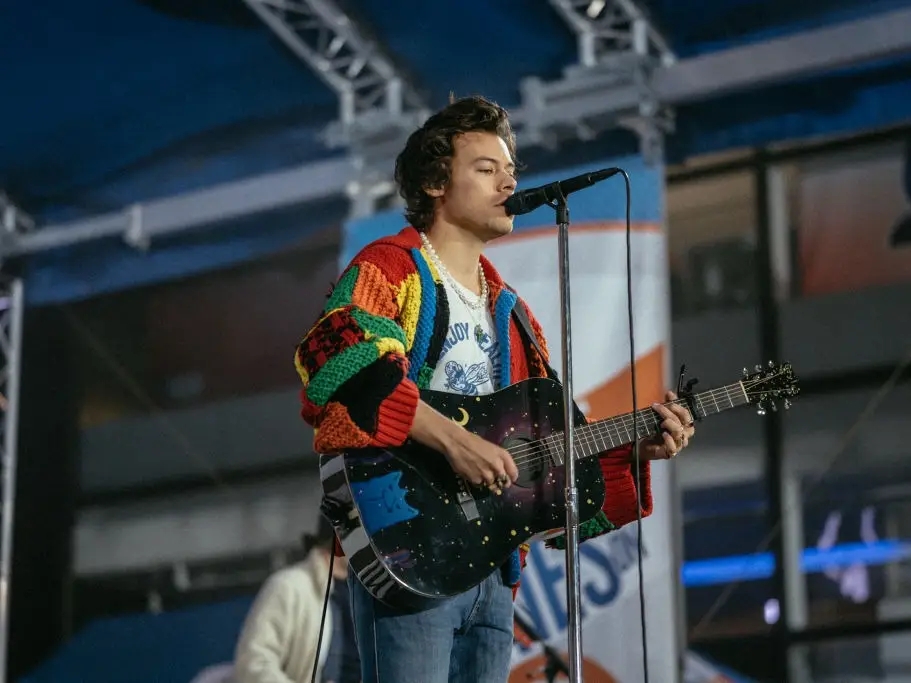
JW Anderson spotted the opportunity and posted the details of the colour pattern as well as a tutorial video on how to create it by yourself. The trend succeeded in gaining over 52 million views, setting the hype for the Women’s Spring Summer 21 Collection of JW Anderson.

References
- Maguire, L. (2022, September 02). TikTok Unboxing: Luxury Fashion’s low-cost marketing tool. Retrieved Septermber 30, 2022, from https://www.voguebusiness.com/fashion/tiktok-unboxing-luxury-fashions-low-cost-marketing-tool
- Depino, F. (2022, September 29). TikTok for Luxury Brands – Opportunities & Examples. Retrieved Septermber 30, 2022, from https://mediaboom.com/news/tiktok-for-luxury-brands/
- Alexis. P. (2021, October 2). How and Why Luxury Brands Should Embrace TikTok. Retrieved Septermber 30, 2022, from https://www.entrepreneur.com/science-technology/how-and-why-luxury-brands-should-embrace-tiktok/382312